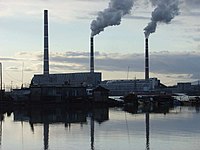
Photo from wikipedia
Selective logging is pervasive across the tropics and unsustainable logging depletes forest biodiversity and carbon stocks. Improving the sustainability of logging will be crucial for meeting climate targets. Carbon-based payment… Click to show full abstract
Selective logging is pervasive across the tropics and unsustainable logging depletes forest biodiversity and carbon stocks. Improving the sustainability of logging will be crucial for meeting climate targets. Carbon-based payment for ecosystem service schemes, including REDD+, give economic value to standing forests and can protect them from degradation, but only if the revenue from carbon payments is greater than the opportunity cost of forgone or reduced logging. We currently lack understanding of whether carbon payments are feasible for protecting Amazonian forests from logging, despite the Amazon holding the largest unexploited timber reserves and an expanding logging sector. Using financial data and inventories of >660,000 trees covering 52,000 ha of Brazilian forest concessions, we estimate the carbon price required to protect forests from logging. We estimate that a carbon price of $7.90 per tCO2 is sufficient to match the opportunity costs of all logging and fund protection of primary forest. Alternatively, improving the sustainability of logging operations by ensuring a greater proportion of trees are left uncut requires only slightly higher investments of $7.97-10.45 per tCO2. These prices fall well below the current compliance market rate and demonstrate a cost-effective opportunity to safeguard large tracts of the Amazon rainforest from further degradation.
Journal Title: Journal of environmental management
Year Published: 2022
Link to full text (if available)
Share on Social Media: Sign Up to like & get
recommendations!